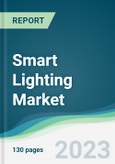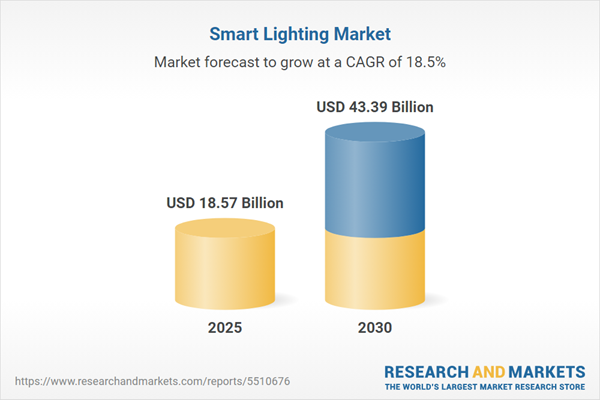The smart lighting market is poised for significant growth from 2025 onward, driven by the increasing penetration of IoT technology, advancements in LED technology, and the global rise of smart homes and cities. With urbanization projected to reach 68% by 2050, according to the World Bank, and electricity consumption expected to grow from 25.67 trillion kWh to 40.44 trillion kWh by 2040, per the International Energy Agency, demand for energy-efficient smart lighting solutions is surging. This report examines key market trends, growth drivers, and regional developments, offering insights for industry stakeholders navigating this dynamic sector.
Market Trends
The integration of IoT technology is transforming the smart lighting market by enabling remote control, real-time analytics, and predictive maintenance. Advancements in LED technology enhance energy efficiency, making smart lighting a preferred choice for urban infrastructure and commercial applications. The growing trend of smart homes, coupled with rising urban populations, is driving demand for connected lighting systems that reduce energy costs. Additionally, the increasing frequency of social and cultural events, such as concerts and sports matches, is boosting demand for high-quality, energy-efficient lighting, attracting significant investments to the market.Growth Drivers
Urbanization and Smart City Initiatives
The global urban population’s growth is a primary driver of the smart lighting market, with the United Nations projecting 68% urbanization by 2050. This trend fuels the development of smart cities, where smart lighting systems, such as IoT-enabled streetlights, enhance urban management and energy efficiency. For instance, India’s Smart City Program, targeting 90 cities, is driving demand for smart lighting through investments in infrastructure and sustainable urban solutions. These initiatives prioritize energy-efficient lighting to support expanding urban ecosystems.Rising Demand for Smart Homes
The proliferation of smart homes, particularly in urban areas, is significantly boosting the smart lighting market. Increasing disposable incomes and a focus on home automation are prompting consumers to invest in smart lighting systems that integrate with devices like Amazon Alexa or Google Assistant. These systems offer remote control, dimming capabilities, and connectivity with smart home ecosystems, enhancing convenience and energy savings. The growing construction of smart homes in countries like India is further amplifying market growth.IoT and Energy Efficiency
The widespread adoption of IoT technology is a key growth factor, enabling smart lighting systems to connect to the internet for advanced features like automatic dimming based on traffic conditions or real-time energy monitoring. These capabilities are critical for commercial spaces and smart city applications, where energy efficiency and operational optimization are priorities. IoT-driven smart lighting supports sustainable urban development by reducing electricity consumption and aligning with global decarbonization goals.Regional Outlook
Asia Pacific: Rapid Growth
India is emerging as a key market for smart lighting, driven by its Smart City Program and rising demand for home automation. Investments in infrastructure and the growing construction of smart homes in urban areas are creating significant opportunities for smart lighting solutions. The integration of IoT technology in projects like smart streetlights further supports market expansion in the region.Global Perspective
While Asia Pacific, particularly India, is a growth hotspot, other regions are also adopting smart lighting to support smart city and home initiatives. Europe and North America are leveraging IoT and LED advancements to enhance commercial and urban lighting applications, contributing to global market growth.Conclusion
The smart lighting market is set for robust expansion from 2025, driven by urbanization, smart home adoption, and IoT-enabled energy efficiency. With global electricity demand rising and urban populations growing, smart lighting solutions are critical for sustainable urban development. Asia Pacific, led by initiatives in India, is a key growth region, while global investments in smart infrastructure continue to propel the market forward.Key Benefits of this Report:
- Insightful Analysis: Gain detailed market insights covering major as well as emerging geographical regions, focusing on customer segments, government policies and socio-economic factors, consumer preferences, industry verticals, and other sub-segments.
- Competitive Landscape: Understand the strategic maneuvers employed by key players globally to understand possible market penetration with the correct strategy.
- Market Drivers & Future Trends: Explore the dynamic factors and pivotal market trends and how they will shape future market developments.
- Actionable Recommendations: Utilize the insights to exercise strategic decisions to uncover new business streams and revenues in a dynamic environment.
- Caters to a Wide Audience: Beneficial and cost-effective for startups, research institutions, consultants, SMEs, and large enterprises.
What do businesses use our reports for?
Industry and Market Insights, Opportunity Assessment, Product Demand Forecasting, Market Entry Strategy, Geographical Expansion, Capital Investment Decisions, Regulatory Framework & Implications, New Product Development, Competitive IntelligenceReport Coverage:
- Historical data from 2022 to 2024 & forecast data from 2025 to 2030
- Growth Opportunities, Challenges, Supply Chain Outlook, Regulatory Framework, and Trend Analysis
- Competitive Positioning, Strategies, and Market Share Analysis
- Revenue Growth and Forecast Assessment of segments and regions including countries
- Company Profiling (Strategies, Products, Financial Information, and Key Developments among others).
Market Segmentation:
By Type
- LED Lamps
- Fluorescent Lamps
- High-Intensity Discharge Lamps
By Application
- Commercial
- Industrial
- Residential
- Automotive
- Others
By Geography
- North America
- USA
- Canada
- Mexico
- South America
- Brazil
- Argentina
- Others
- Europe
- UK
- Germany
- France
- Italy
- Spain
- Others
- Middle East and Africa
- Saudi Arabia
- UAE
- Israel
- Others
- Asia Pacific
- Japan
- China
- India
- Australia
- Others
Table of Contents
Companies Mentioned
- Acuity Brands Lighting
- Lutron Electronics
- Johnson Controls
- Osram
- Daintree Networks
- General Electric
- Honeywell International
- Philips
- The Smart Lighting Company
- Svarochi
Table Information
| Report Attribute | Details |
|---|---|
| No. of Pages | 148 |
| Published | July 2025 |
| Forecast Period | 2025 - 2030 |
| Estimated Market Value ( USD | $ 18.57 Billion |
| Forecasted Market Value ( USD | $ 43.39 Billion |
| Compound Annual Growth Rate | 18.5% |
| Regions Covered | Global |
| No. of Companies Mentioned | 10 |









